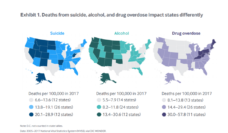You knew that someday your contract would end. You’d finally return home to your friends and family and put the military behind you. The thought gave you so much hope that you started counting the days with 1,200 left to go. When that day finally came, your heart splintered. The world you imagined was just a fantasy. Home was no longer home. People moved. People changed. The world kept moving without you. You sank into deep depression.
For some veterans, the transition from military service to civilian life is a more challenging experience than service itself. It can be so intolerable that 6,139 veterans took their own lives in 2017, a number representing 6.1% of total US adult suicides that year. Chandru Ravindran and colleagues analyzed health information from nearly two million veterans in the six years post-discharge to understand who is at greatest risk of suicide and when they are most vulnerable.
The graph above compares veteran suicide rates across the Air Force, Army, Marines, and Navy. Suicide rates across these four branches of the US Armed Forces steadily increased until the end of the first year after discharge. Over the next five years, rates in all branches stabilized. Army and Marine veterans consistently experienced the highest rates of suicide.
Ravindran’s team speculates that each branch appeals to different types of people. For example, women represent 25% of Navy enlisted personnel, compared to 10% of Marines. Men are 3.56 more likely to take their own lives than women.
The researchers also speculated that differences in branch culture, training, and deployment may contribute to suicide rates. For example, Army Soldiers deploy for up to 15 months at a time, compared to nine months for Navy Sailors. Longer deployment cycles are linked to higher rates of post-traumatic stress diagnoses, especially in the Army. Those who experience PTSD are more likely than others to take their own lives.
Databyte via Ravindran C, Morley SW, Stephens BM, Stanley IH, Reger MA. Association of Suicide Risk With Transition to Civilian Life Among US Military Service Members. JAMA Netw Open. 2020;3(9):e2016261.














